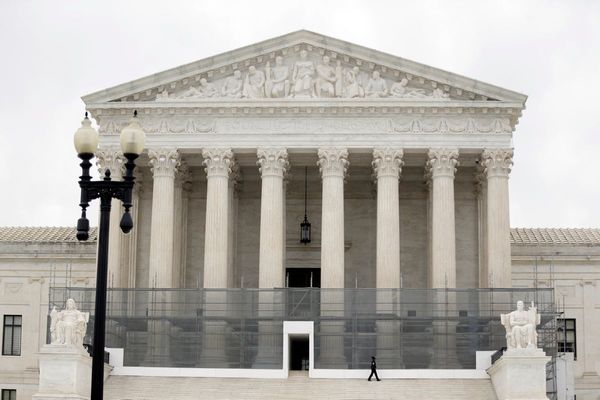
The black sailor lies back on his broken, doomed craft. All around him, the sea chomps and shudders. And there is a storm coming, to judge from the spinning column of grey water on the horizon. A ship is ploughing through these troubled waters but will it care enough to help? The sharks seem to know it won’t. They expect a meal any moment now. They roll and glide by the boat, flashing their giant mouths and tiny eyes.
This is Winslow Homer’s 1899 masterpiece The Gulf Stream, and there could not be a more timely loan to the National Gallery from New York’s Metropolitan Museum of Art as the US is consumed by its history of racial injustice and premonitions of disaster, even of a second civil war. Is America doomed, like this sailor? Is it a wreck about to be torn apart by its own divisions, savaged by the circling shark of a second Trump candidacy? Homer hasn’t any answers but he poses the question of how a nation with such a legacy of slavery can ever escape its past.
The Gulf Stream deserves to be a US icon, a painting that says more about its past, present and possible future than Warhol’s Marilyn. Black artists chew on it wittily. Kara Walker recreated it as a disaster-theme-park fountain with fake sharks in her 2019 Tate Turbine Hall commission Fons Americanus. Kerry James Marshall has repainted it as an optimistic vision of a black family sailing under serene skies, not a shark in sight.
The power of Homer’s painting lies in the human figure. We wonder what the helpless man is thinking, what his posture signifies. Is he hopeful or despairing? Does he have a final trick up his sleeve to get out of this apparently inescapable situation, like plucky Chief Brody at the end of Jaws? The man is doing what his physical situation demands: if he stood up on the tiny sloping deck he’d totter into a shark’s mouth. So he lies down, holding on to ropes with both hands to stop himself sliding overboard. And he raises his upper body, resting on an elbow, to survey the sea. He might be looking for help. Or he could be just getting his last sight of life.

The enigma of the man’s attitude is emphasised, for Homer, by his blackness. For this is a painting by a white American male born in 1836. The great achievement of the National Gallery’s eye-opening odyssey through Homer’s art is to show how he came to imagine this scene and why it sums up his entire life’s work. The recurring themes of that work are race and the sea. And he worked hard, sometimes with touching clumsiness, to get them both right.
When the civil war broke out in 1861, Homer was a young artist dispatched by Harper’s magazine to cover it. His early paintings, derived from his on the spot sketches, are coolly shocking. Sharpshooter depicts a Union soldier in blue uniform sitting in a tree, aiming his rifle with a telescopic sight to pick off Johnny Reb at a distance. The shooter’s face is a blur, with no expression we can read. Here is an early sign that Homer finds people as hard to interpret as the sea.
There are hints too of the symbolic power of his later work. The Veteran in a New Field was painted in 1865, the year the south was defeated. It’s hard to mistake for simple reportage. A former soldier is back on the land but as he scythes, his back to us, there’s a terrible unease. He could be the Grim Reaper. Uncountable strands of corn stream towards us like all the lives cut down by war.

Homer sticks around in the south, trying to connect with freed enslaved people. He paints a white former slaveowner encountering an ex-slave family in his 1876 picture A Visit from the Old Mistress. The white woman seems frozen. Subtlety of expression is reserved for the black women who gaze at her with much more in their eyes that can ever be said – a lifetime and more of questions and accusations.
The artist identifies with the white visitor, in the sense that he feels awkward and frozen too. Paraphrasing Damien Hirst, Walker called the part of her Turbine Hall fountain sculpture that was based on The Gulf Stream The Physical Impossibility of Blackness in the Mind of Someone White. Homer grapples with that problem. You can see him trying to find an adequate way of depicting blackness and doing justice to black Americans in his art. But it does not come easy. Nor for that matter does he always get the sea right – he’s easily distracted by Victorian “swimming dresses” that in one painting cling wetly to a woman’s body and in another, not completely surprisingly, have dragged two women down and half-drowned them.
Homer can be a clumsy artist. Yet, for all the clunking moments, there is an intensity and passion that carries him through to his masterpiece. Some artists are born great; others have to work like hell for it. Homer lacks the natural brilliance of Turner. His work can be as deeply chromatic and wild as an Atlantic storm one minute and a bit dull the next. But he has a self-questioning toughness that finally, on the eve of the 20th century, enabled him to create The Gulf Stream, a vision of America that bites us now and won’t let go.







